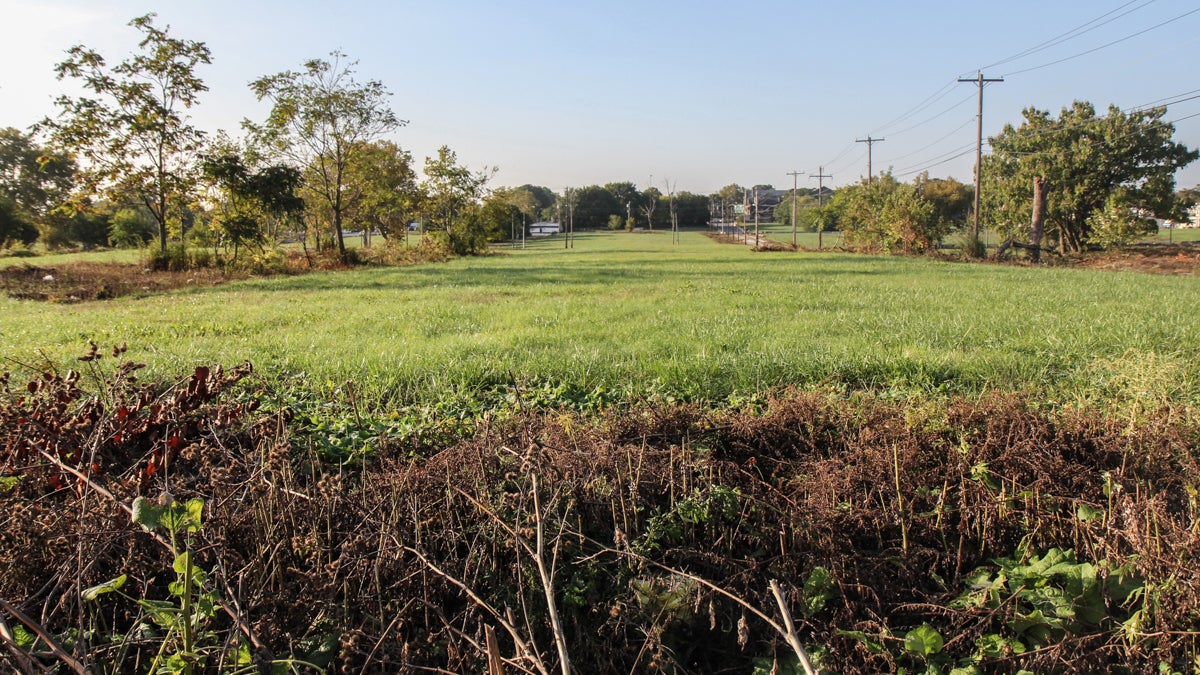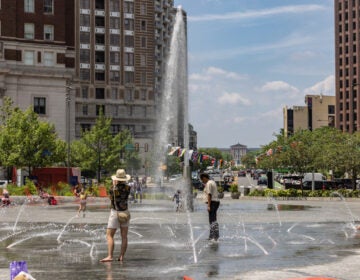Philly and developer planning project to rise in Logan, site of sinking homes
Listen
This is what’s known as the Logan Triangle, an infamous, 35-acre slice of North Philadelphia history that residents, city officials and, now, a private developer hope to finally rewrite after three decades.
On an oven-hot morning, a band of men in blue jumpsuits is raking up trash tangled into the edges of Ninth Street near Roosevelt Boulevard in North Philadelphia.
It’s early, but the guys with Ready, Willing and Able — a nonprofit that helps the homeless — have got a lot of work ahead of them.
Through the brush just around the corner, longtime Logan resident Ernie Bristow scans a vast expanse of grass and weeds.
She shakes her head.
“You gotta beg for somebody to come clean up. It’s just sad,” said Bristow.
From a distance, the lot looks like the makings of a football field. But walk in, and you’ll quickly find reminders of what stood here and on nearly 20 city blocks nearby: houses.
Hundreds of them.
“It’s still devastating,” said Bristow. “People don’t want to come over here.”
Here is what’s known as the Logan Triangle, an infamous, 35-acre slice of North Philadelphia history that residents, city officials and, now, a private developer hope to finally rewrite after three decades.
In the late 1980s, the city started spending millions to demolish nearly a thousand houses within the triangle, an area bordered by the Boulevard and Seventh Street and 11th and Louden streets. Millions more were spent relocating the people who lived in them.
The reason: the houses were sinking. They were built in the 1920s on top of a creek bed filled in with ash and cinder. Over decades, that combination behaved like slow-moving quicksand. And, ultimately, punctured a once thriving neighborhood.
“My children, when they were young, were able to come in and out [of the house]. Sometimes, they forgot to lock the door and it was no problem. Nobody can do that now,” said Helen Matthews, who moved across the street from the triangle before the demolitions started.
Fluid plans, perhaps an orchard
That history is part of what led The Goldenberg Group to ink a deal with the city after months of negotiations.
Jeremy Fogel, the Blue Bell-based company’s director of development, says the project is still very much a work in progress and that it’ll be shaped with the help of neighbors.
Generally speaking, however, the plot may feature a mix of for-profit and not-for-profit uses along with some community open space.
“Those kind of broader brush, big picture concepts will need to be adopted into whatever specific designs we eventually end up with,” he said.
The project may also incorporate elements of an alternative proposal being pushed by a grassroots group known as LOAM, short for Logan Orchard and Market.
The concept includes plans for parks, greenhouses, solar cottages and, of course, orchards.
“We would directly meet the basic needs of the people of this lower-income neighborhood for fresh food all year, genuinely low-cost housing, health care, jobs, business development and training,” says Mt. Airy resident Paul Glover, LOAM’s founder.
The Philadelphia Redevelopment Authority owns the land that comprises the Triangle. Executive director Brian Abernathy says it won’t be easy, or cheap to build there.
As it stands today, only about half of the Logan Triangle is suitable for redevelopment. The center of the site is particularly unstable.
“There’s a potential that I fail — that the authority fails. The government subsidy that’s needed will be pretty significant,” said Abernathy.
“I can’t promise that we’re going to be successful in a year or two years or three years or five years. But I can commit that we’re in it for the long haul, that the status quo isn’t acceptable and that we have to figure this out, not just for the future of Logan, but the future of the city.”
Explosion exposes instability
It all started in 1986 with a big gas main explosion. The Valentine’s Day blast damaged several homes, but it also revealed just how badly properties in the Triangle were sinking.
“As you drove along the Boulevard and looked at Logan, you could literally see houses where the steps of the houses were higher than the front porches of the houses and that’s because the houses were heavier than the steps,” said Deborah McColloch, the city’s housing director.
In 1987, the city started condemning properties and offering buyouts to residents of the Logan Triangle on a volunteer basis. A nonprofit, the Logan Assistance Corporation was set up for the sole purpose of overseeing the process.
The work was projected to take three years. In the end, it took the better part of two decades. The last family moved out in 2003.
“It was a very difficult time,” said McColloch. “Some people wanted to leave and get out of there. Other people didn’t want to leave. They didn’t believe the houses were really sinking. They didn’t believe it was as bad as it was.”
Over the years, two major development proposals were presented to city officials, including one from Goldenberg. Bart Blatstein, the man behind high-profile projects like the Piazza at Schmidt’s in Northern Liberties, submitted the other plan.
Both called for large-scale housing. Both were rejected.
Expensive proposition
Cost was a big factor and, specifically, the cost of preparing the land for redevelopment. Those are dollars the city would have had to contribute.
One proposal required $40 million for remediation.
“That was just the start of it. So it clearly wasn’t going to work,” said John Kromer, who directed the city’s Office of Housing and Community Development while Ed Rendell was mayor.
That was a big source of frustration for City Councilwoman Marian Tasco, whose district included the Triangle until 2011. Year after year, she met with residents with little hope of things changing for the better.
“Internally, I knew it was just impossible, but I never said it was impossible. I just kept working with [residents] and working with the administration to see what we could do on that property,” said Tasco.
“It was not that I didn’t want to help or build, it’s just given the facts of life of that land, what we’re you going to do and who do we get to do it?”
Abernathy, with the redevelopment authority, says it’s unclear how much remediation would cost for the current project. But he estimates the bottom line could be upwards of $100 million.
The new project may feature housing, but it’s not guaranteed. Part of that decision will hinge on whether residents want to see that and would people be willing to buy a house on land that is most famous for sinking.
WHYY is your source for fact-based, in-depth journalism and information. As a nonprofit organization, we rely on financial support from readers like you. Please give today.





